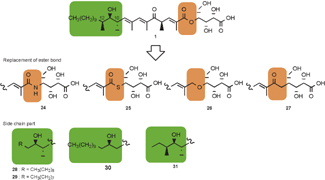Large-scale synthesis, design, and structure–activity relationships of khafrefungin are reported. Khafrefungin is an antifungal agent that inhibits inositol phosphorylceramide (IPC) synthase, an enzyme involved in fungal sphingolipid biosynthesis. Unlike other inhibitors that inhibit the corresponding enzyme in fungi and mammals to the same extent, khafrefungin does not impair sphingolipid synthesis in mammals. We have developed an efficient method for large-scale synthesis of khafrefungin, and various khafrefungin derivatives were synthesized based on this method. While most of the khafrefungin derivatives lost antifungal activity, a lactone-type derivative had almost the same activity as khafrefungin. We also designed and synthesized derivatives which contain a five- or six-membered ring at the central part of the structure based on NOE experiments of khafrefungin. A macrocyclic khafrefungin derivative was also synthesized, but the antifungal activity was lost. These results suggest that the structure of khafrefungin might be strictly recognized in fungi.

You have access to this article
 Please wait while we load your content...
Something went wrong. Try again?
Please wait while we load your content...
Something went wrong. Try again?


 Please wait while we load your content...
Please wait while we load your content...